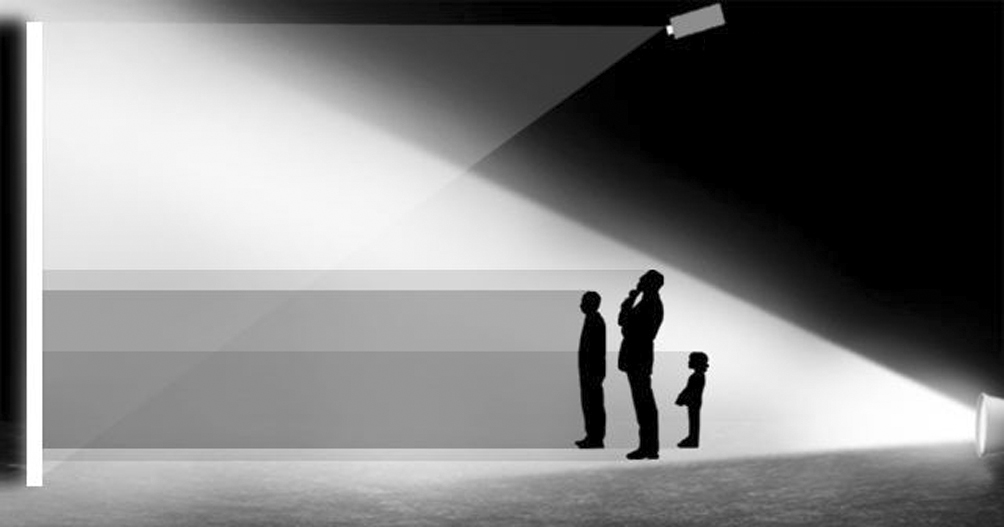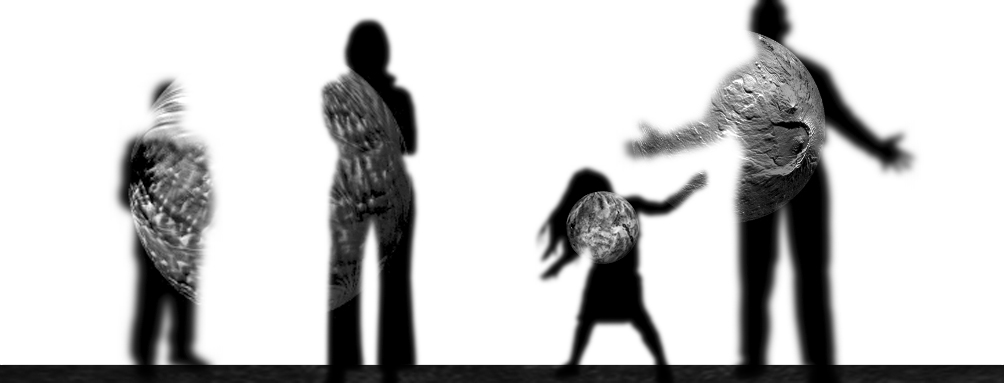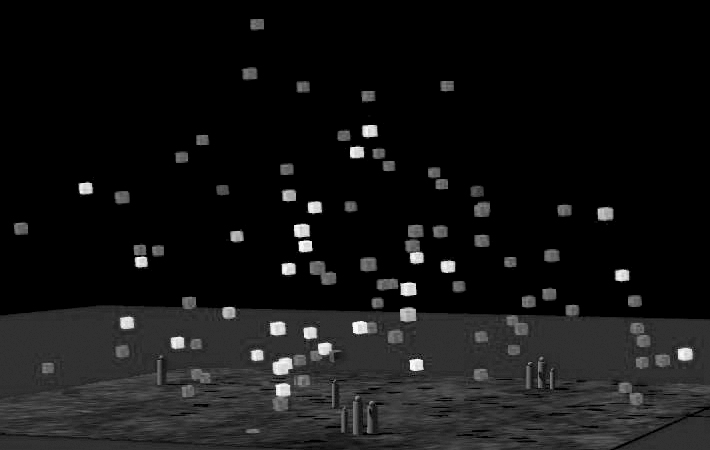Daniel E. Goods – « You Want to do What? » Being an Artist at the Jet Propulsion Laboratory – 2004
Artist
First publication workshop Space: Science, Technology and the Arts in collaboration with ESA/ESTEC, 2004
Introduction
Walking down Mariner Road at the Jet Propulsion Laboratory, I asked a grad student next to me why he was so interested in JPL. He replied, « JPL dreams up missions that seem impossible and say they will do it within 10 years. Then they do it! » As we talked, I started to realize how similar my mentality as an artist is to that of the engineers and scientists that I work with. As an artist and designer, I am constantly trying to challenge myself to do things that have never been done in order to communicate ideas in a compelling and unique way. Using the term media agnostic to describe myself, I want to find the most interesting way to communicate an idea. Often times my solutions are such that when told, people smirk and say, « You want to do what? That’s crazy. » Artists have always been pushing the boundaries using materials and techniques in ways that are new and unusual. They are experimenting with reality just as their counterparts in science do. It is this mentality that Tony Freeman, my original manager, had when he first asked me to work at JPL. He had seen my work with David Kremers, the Conceptual Artist at the California Institute of Technology, where I researched how transparency and iridescence could display relationships between large sets of data. My unusual research included swimming like an otter and taking imagery of objects that were transparent or iridescent. This visual and experiential reference was then applied to a computer interface [1]. Seeing this unusual process work, I was asked to develop unconventional ways of communicating a mission to the public. Tony did not want a brochure, web site or something that looked like science fiction from the 1960’s, but something new that would push the boundaries of our communication to the public. I chose to work with the Terrestrial Planet Finder Mission (TPF), which, if it successfully finds another planet like earth, would be one of the greatest of all human discoveries.
For an average person looking through the material, this is a very complicated mission. Two types of spacecraft will be flown: a multi-lens infrared interferometer flying in formation and a large optical chronograph. Just trying to pronounce these can be difficult, let alone explaining them to someone. They each use different techniques to accomplish essentially the same task – to block out the overpowering light of a star in order to see the small faint light of an earth like planet. They will analyze spectra in order to detect signs of ozone, carbon dioxide and water, which are all chemicals needed for a planet that we would call hospitable to life.
What is unfortunate is that after years of research and billions of dollars all that this mission will have to show to the general public is a single white pixel on a dark background, a speck most people will mistake for dust, asking « what’s so special about this? » There will be no high definition panoramic images of foreign landscapes in far off lands, but just the spectra of what might be a place we can live. In light of this, I realized that the specifics of the mission were not as important as helping people understand the purpose and significance of the project. Creating an experience where people would intuitively start asking the bigger questions about who we are as humans and our relationship to the universe was my challenge.
The Playground, a sand installation
The immensity of the universe was the first and biggest impact on me while researching TPF. My background in astronomy is very limited, so when I first heard about a mission to find earth-like planets I was more than a little skeptical. Could there really be another planet like earth? What would it mean if we were alone? What would it mean if we were not? Up until then, I hadn’t been fully introduced to the scale of the known universe. As I researched, I realized that our galaxy has approximately 400 billion stars and that there are hundreds of billions of galaxies. I have been given many analogies of big numbers, but my visual nature wanted to « see » billions of objects. Once I had a mental image of the size of the universe, I was forced to reconsider the possibility of finding another planet like earth.
To duplicate this process and show the vastness of what is known to the average person, allowing them to decide for themselves whether or not there could be other planets like earth or not, I have created an installation called The Playground seen in Fig. 1. In it, I use a single grain of sand to represent an entire galaxy. At this scale it takes 7 roomfuls of sand of to contain all the galaxies in the known universe. I took one of those grains of sand, which would represent our Milky Way Galaxy, and I had a hole drilled into it that is 1/10th the size of the grain of sand. This hole, which is seen under a magnifying glass, represents the area in our galaxy in which we have looked and already found over 120 planets.

It is one thing to have a concept to drill a hole into a grain of sand. It is another to actually do it. When I spoke to the Space Flight Instruments Shop at JPL, who are accustomed to milling tiny structures out of metal with tolerances of wavelengths, I asked them if they could drill into a grain of sand for me. One guy looked at me with a perplexed face and I knew what he must be thinking – « You want to do what? » Fortunately the other person said, « oh cool! » and his mindset won out. There was a lot to figure out since they had never tried to drill into a rock before. What kind of rock would be best? What did it have to look like? I spent hours looking through piles of sand with a 15x magnifying loupe trying to find the perfect grain. It had to be 1mm wide because the hole was going to be .1mm, impressively small yet large enough to be seen at 15x magnification. It had to be black, because it was to be backlit, somewhat oval, to represent our galaxy, and very flat, so the drill could go through. Once I found a few grains that they liked, they placed wax on them and attached them to the drilling surface. The hole was drilled using a carbide drill bit. The grain was then cleaned in a sonic cleaner and is now placed under a 15x lens for viewing.
This installation would be experienced differently depending on its location. In general, people walk into this enormous amount of sand and are encouraged to play with the sand, to feel the galaxies slip through their fingers and imagine shaping them as if they were gods. The magnifying glass would be set up on a stand a distance away and the sand would be arranged so as to heighten a sense of infinity. To then see the incredibly small area we have explored is powerful. There is so much we haven’t been able to see in our own galaxy, let alone in the universe.
I am working on plans for this installation to have various shapes for different locations. The sand can be arranged to resemble large-scale structures in the universe such as the Sloan Great Wall, or other shapes like a Fibonacci spiral or in a way that would take advantage of a sunrise or sunset. The beach would be a logical place and there are several events that the installation could work well with. With NASA’s desire to reach out to a younger generation, I am looking into venues such as beach volleyball and surfing competitions that gather upwards of 30,000 people. These are locations one would not expect to see artwork from NASA, yet it would seem natural. In addition, I am currently talking to other venues that range from museums to science centers for indoor and outdoor installations. Taking the sand outside of its normal environment, and into a museum setting would add another dimension to the piece.
Light / Shadow installation
For another installation I chose to address the basic idea of the mission. Stars are billions of times brighter than the light reflected off of the planet we are looking for, so blocking out the light of the star is key to the success of the mission. Whether this is done with an interferometer or chronograph, the specifics of how each technique works is not critical for the public to understand. So I focused on the idea of blocking out a bright light to see dim light for this project.
To express this idea, I use a movie projector and a bright light. As seen in Fig. 3, a projector is placed about 3m off the ground and it projects a movie, about 7.5m wide by 6m tall, onto a large surface. At the same time, a 12,000-watt (12K) spot light shines on the same surface. The spot light is underneath the projector on the ground and puts out so much light that the movie is invisible. All that is seen is a white glare, but as in Fig. 4, when a person walks in front of the light, his or her shadow hits the screen, revealing the movie inside the shadow. The more people in the installation the more of the movie you will see. People seem to love to see large shadows and can be entranced by the exhibit for sometime.

The movie consists of two parts. Non-earthlike planets, which I digitally designed and animated with software, spin across the screen. Every once in a while, an earth-like planet will fly by followed by movies of water, one of the elements we are looking for. Sometimes the water is easily identifiable and at other times it is abstract, letting the audio cue the viewer as to what it is. This loop will last for about 10-20 minutes so that a viewer can come and go and see different things each time.
Utilizing stereo sound, and in the future surround sound, music becomes a vital element to guide the viewer in the installation. As an earthlike planet appears on the screen a heartbeat is played signaling that this is a place suitable for life. I wanted the non-earthlike planets to sound as ominous and foreboding as possible so I collaborated with John Carpenter, an artist at the California Institute of Technology. He took the audio tracks of water, distorted them in various ways and remixed them. We then added those sounds to the non-earthlike planets. Each planet has its own unique sound, which pans with the planet from one side to the other in stereo sound. The result is waves of techno beats flowing across the viewer’s space.

This project raised a lot of questions. « 1200-watts? Aren’t you going to blind people with that? » « There will be too much ambient light. It can’t be done. » « Where are you going to get the power to run that thing? » All are questions that I asked myself, but found answers to after some trial and error. The biggest issue was to find the right balance between the projector light and the spotlight. If the spotlight is too dim you can see the movie through the light. If the spotlight is too bright, ambient light will wash out the video. In addition I wanted 1-10 people to be able to interact with the installation, so the light had to cover a large space. Living near Hollywood I didn’t have to look very far for big lights. I found a 6K light that worked, but only for a space of about 3m, which is not large enough for a crowd of people. I then found a 12K HMI Solar-arc Lamp by Mole Richardson, which is often used for shooting daytime scenes at night. After talking to the representative, it was clear that this light is designed for use with people, so just as long as no one stared at it, things would be fine. The 12K light, combined with a 3500 ANSI lumen Sanyo XP-41 projector, is a good balance to see the most vivid image inside a shadow without seeing an image outside the shadow. In addition, I am researching if different filters will allow more contrast between the movie and the spotlight.
There are some difficulties with the 12K light, though. It does take a lot of power (100 amps) and is somewhat expensive to rent at $600US per week. As long as this is being shown in a location with big buildings and friendly electricians, the power is not a problem. Otherwise a portable power plant can be rented to run it at an additional cost.
Depending on how long the installation will stay somewhere and who is hosting it, I am budgeting to split the rental fee with the host to cut down on rental costs. Long-term contracts with the owners of the light will also make it more cost effective.
Target star sculpture
A list of about 130 target stars has been created for the TPF mission to focus on. These stars are within 100 light years of the earth and are believed to be most likely to have earthlike planets around them. I am developing a large three-dimensional map of these stars, as seen in Fig. 4, that will interact with a viewer as he or she walks through the 35-40m space. Each of the target stars is represented as a glowing locked box suspended by poles or dug into the ground. They are placed according to their position in three-dimensional space. Each box is colored to represent the temperature of the star and is made out of acrylic, internally lit with LED’s (Light Emitting Diodes). Most boxes are closed with locks on them, but a few are partially opened, representing the planets we have already found around these specific stars. One box in the center, representing our star, is completely opened with a representation of our solar system inside.

In trying to make my projects a dynamic experience for the viewer I have designed the sculpture to update in a few ways. When no one is walking inside the sculpture, the light of the boxes will slowly undulate between 70-100%, all at different rates. There will be several motion sensors spread through the sculpture which, when triggered, will cause the surrounding boxes to twinkle as a person walks through. In addition, to represent the planets that we have found, the lights will be programmed in such a way as to make it look as if there is a planet inside the box. Then, as more planets are found around the target stars, the sculpture itself will update by having more boxes open and the lights inside of them animate. There are various precursor missions, including the Space Interferometry Mission, which will look for planets around these stars. This information can also be used to update the sculpture.
Since each box represents a star, a star will be used to power the sculpture. Solar panels will be placed on certain boxes to catch the most sunlight and batteries will drive the lights at night. If the sculpture is placed in a location that is cloudy, it will have a backup line to plug into the current grid.
I will soon be conducting a feasibility study with a subcontractor that will cover all aspects of the design. Issues include how tall the poles can be, how much power will be needed, and what specific materials will be used. At this point, a working prototype has been made to demonstrate what the boxes will look like and how, in general, the lights will undulate and respond to motion.
I am hoping to have the sculpture placed in fields at universities. It will be designed to break down and travel to a new location every year or two. Getting the necessary cooperation and consent to set the sculpture up in the different venues for that length of time might be a challenge, yet there has been tremendous support for the project so far, and I hope this will extend to its final creation.
Conclusion
Some scientists do not understand what an artist can bring to their work, but most of them have a desperate need to be able to communicate what they are doing to the general public. After a few weeks of working at JPL, many scientists began to realize how an artist can take their information and not only communicate it, but do it in a compelling and experiential way. Reading a poster or web site can get facts across, but an experience can engrain concepts into a person.
For the most part, I have received overwhelming support for my proposals and have been given funding to pursue them. This has allowed me to go from PowerPoint presentations to prototypes, and I am now in the phase of finding venues for all of these projects. Full-scale versions of the Light / Shadow installation have already been shown at a few locations as well as a small-scale version of The Playground. After showing these projects to a variety of scientists and engineers, they feel that I am able to present their own work in ways that they had never thought of before. Since each of these media are completely new to me, it has been extremely satisfying to create installations that are stretching the way JPL talks to the general public, as well as the people who are inventing the future. This, I hope, will continue.
This work was performed at the Jet Propulsion Laboratory, California Institute of Technology, under a contract with the National Aeronautics and Space Administration.
© Daniel E. GOODS & Leonardo/Olats, mai 2004 – republished 2023
Leonardo/Olats
Observatoire Leonardo des Arts et des Techno-Sciences
À propos / About | Lettre d'information Olats News



Pour toute (re)publication, merci de contacter / For any (re)publication, please contact Annick Bureaud: info@olats.org
Pour toute question concernant le site, merci de contacter / For any issue about the website, please contact: webmaster@olats.org
Design Thierry Fournier
© Association Leonardo 1997-2022